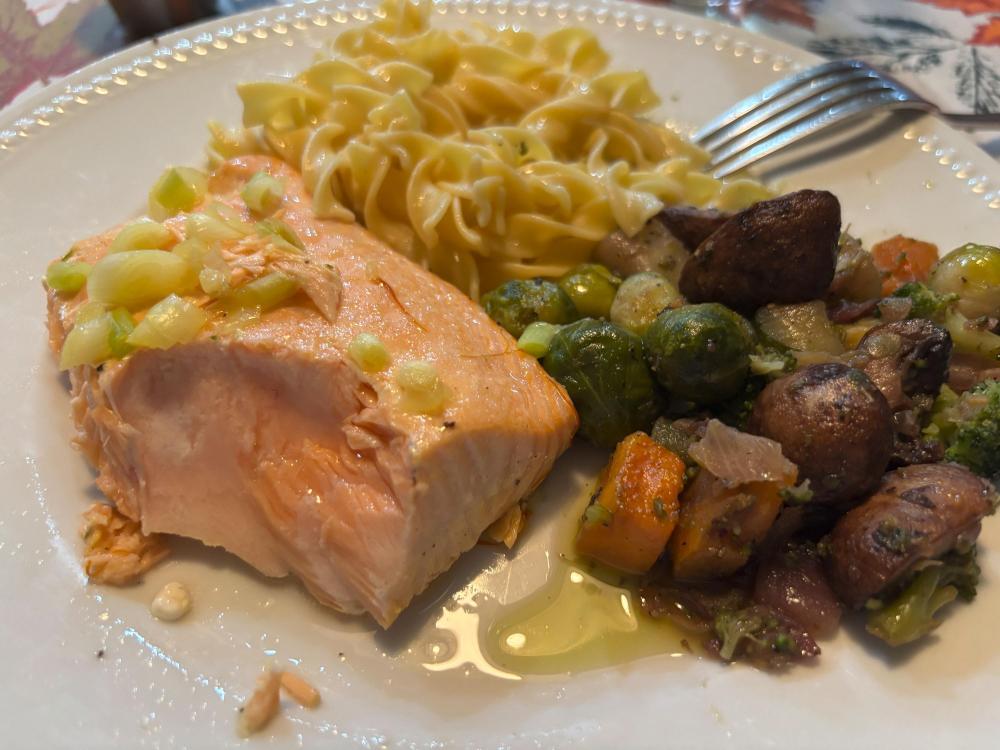-
Posts
1,612 -
Joined
-
Last visited
-
well, I don't know about anybody else, but the topic/post caught my attention because I have, independent of "experts," found that potatoes do better with more salt than one might suspect.
-
it seems a number of "other experts" do have thoughts about salting potatoes . . . The Pioneer Woman: "Fill a large, heavy-bottomed pot with water and salt generously. Just like cooking pasta, you want the water for potatoes to be salted generously. Since potatoes are quite bland and starchy, they need a lot of salt (more than you think!) to transform into a flavorful, savory vegetable side dish." Serious Easts: "Add more salt than you think. This is especially important when cooking whole, skin-on potatoes, since the skin acts as a barrier that slows salt absorption; under-salting the water will leave them bland inside. I'm pretty aggressive with the salt in my potato water, making it at least as salty as pasta water (which should be around 1 to 2% salinity, or, as I describe it, as salty as your tears), and sometimes even more so—pushing into true "salty as the sea" territory of around 3% salinity." bon appetit: "Two keys to perfectly boiled potatoes: time and salt. (Like, a lot of salt.)"
-
yup. sea water has ~about 35 grams of salt(s) per liter so . . . cooking pasta in a 3 quart pot, that'll require ~99 grams of salt the glitchy part comes in at . . . what kinda' salt cho talking 'bout, Lewis? 1 tablespoon of "kosher" salt does not weigh the sames as 1 tablespoon of Morton's table salt . . . I use kosher type salt, so that would require almost 7 tablespoons of kosher salt in a 3 quart pot. or . . . 5.6 tablespoons of the table salt grind size..... nevertheless&all that - not too many cooks use that much salt to boil pasta . . .
-
homespun egg rolls . . . definitely easier to get from the hot food prep section of the market . . . .
-
saffron poached salmon with pan roasted veggies + noodles. really good, if the cook does say so himself . . .
-
@BeeZee poor trim / prep. there's a tendon that runs down the inside of the breast - just like a chicken breast. one resto sliced the breast - and half or more of the slices had a chewing wad one had to 'work around' that visit was the second disaster dinner, so we don't go there anymore....
-
I guess one question is 'why so tough?' now,, freezing is not a good tenderizing method . . . (sigh) if frozen is all you can get . . . for poultry I'm very fond of (oven) low temperature cook - like 200-210'F followed by browning/searing/grill marks/make pretty. without a single question this side of the moon, over cooking chicken/duck/turkey makes it tough. stop at 140'F, use the carryover heat.... poaching is an excellent method - fish/chicken, etc.. just barely simmering water - keeps the meat wet/moist. these method do not lend themselves to "instant dinners" however. example chicken breast - #1 if it's two inches thick, go to Chic-Filet.... I sliced in half thickness wise - poaching (starting with a frying pan of hot water) only takes <10 minutes. instant read thermometer highly useful.
-
I'm a sucker for cute very utile doohickies - nice find!
-
I think omelets get foisted as 'an ideal' simply because the basics are extremely simple. eggs pan heat no "special stuff" needed. three day reductions etc. etc. etc. . . . not needed . . . so, iffin' it is so simple, how come it's 'so hard?' just about every person on the planet has had a delicious omelet. so what happened? imho, the first issue is , , , cooking an omelet is much more about technique than other mentionables. one has to recognize when the pan temp is right - one has to correctly judge when the omelet is 'set' that can take a bit of learning/experience - for people who wish only to master minutes+seconds+power level for the microwave.... that can be an issue. there is another aspect to 'OMG that was a good omelet!' - which is 'seasoning' - a salt free omelet . . . not gonna' cut it. then the 'fillings' . . . more is not more better. too much volume, the omelet is not well behaved on 'rolling out' the fillings also have a huge effect on 'seasoning' aka taste . . . cheddar vs. Asiago . . . worlds apart, for example. I did an interesting approach recently - used a stick blender to 'whip up' the eggs+dab of water. that introduces a lot of air and hence physical volume to the omelet 'mix' - 'filled' a ten inch pan noticeably more than 'usually expected.' it worked - requires lower heat+more time, turned out more pure eggish blanched style. ... frankly I'm more a fan of the "country style" omelet where it is entirely permissible to have some slight browning.
-
steelhead are genetically identical to rainbow trout . . . in nature, they spawn in fresh water rivers, but "go to sea" for their adult life. lots of details here https://fishermansauthority.com/how-to-catch-steelhead/
-
yuppers - that's the good stuff... our Costco packs it in both 1 filet and 2 filets per package. two is a bit much . . . altho even with one side I divide it into 3 or 4 "meal size" pcs, freezing what we don't eat 'that day' ....which is why I don't buy their huge qty of salmon - it's not tasty to re-freeze previously frozen . . . .
-
several states (west coast) and the Federal government list steelhead trout as 'endangered' - so one rarely find wild caught. at our local PA Costco it is fresh/never frozen - farmed in Norway. most/all? of the salmon Costco carries is farmed, from Scotland - but "previously frozen' pricing is similar tho....
-
does your Costco carry steelhead trout? looks like salmon, slightly different, really good. our fav use for the rostissed chick is 'a meal' + chicken salad, then simmer down the carcass for chicken noodle soup base. when it gels, you get super stock for the soup!
-
Nuwave and Salton came up in my searches for "with probe" Salton seems to be 'only x left' on most sites - are they still a viable company? the Nuwave - at 1/10th the price - looks like a decent alternative . . .
-
I always froze excess garden green beans 'uncooked - unblanched - whole - untrimmed' I would chill them, then spread very thin on a cooking / roasting sheet, into the freezer. my 'take' on IQF - put the frozen beans in a freezer zip lock. that way I could extract/cook as many as I needed. in my experience, cooked/boiled/steamed green beans become greenish mush when frozen-then-thawed....












